B-24 Liberator Willow Run Assembly Plant
The Consolidated B-24 Liberator was a 4-engine, twin-tail heavy bomber designed by Consolidated Aircraft of San Diego. Its first flight was on December 29, 1939, and it began service in 1941.
The B-24 was a more modern design than the Boeing B-17 Flying Fortress, with a higher top speed, greater range, higher ceiling, and a heavier bomb load. But the B-24 was more difficult to fly, with heavy control forces and poor formation-flying characteristics. The positioning of the fuel tanks also made the plane prone to fire. The high fuselage-mounted wings also made it more difficult to survive crash landings on land or water.
The B-24's spacious, slab-sided fuselage was built around a central bomb bay with two compartments that could accommodate up to 8,000 pounds of ordnance each. The B-24 provided excellent service in a variety of roles due to its large payload and long range.
B-24 Liberator Production Recap by Model and Assembly Plant
A total of 18,493 Liberators were built, more than any other aircraft in World War II. Several factories produced the Liberator:
- Original Consolidated plant in San Diego
- A second Consolidated plant in Fort Worth
- Ford Motor Co. at Willow Run, Michigan
- North American Aviation in Dallas
- Douglas Aircraft Co. in Tulsa
Willow Run Plant in Michigan
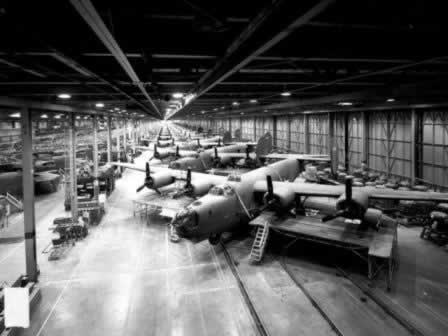 B-24 airplane assembly line at San Diego |
The Willow Run manufacturing plant, located between Ypsilanti and Belleville, Michigan, was constructed during World War II by the Ford Motor Company for the mass production of the B-24 Liberator.
In December 1940, the federal government asked the Ford Motor Company to build 1,200 B-24 bombers. Ford's chief engineer, Charles Sorensen, quickly devised a then-untried scheme of mass-producing planes.
The government agreed to the plan, and on April 18, 1941, five weeks after receiving an initial $3.4 million contract to build B-24 subassemblies, construction began on what would become the world's largest assembly plant. The plant was dedicated on June 6, 1941.
The plant was located on a rural site, owned by Henry Ford, that had been a farm to provide summer employment for youths.
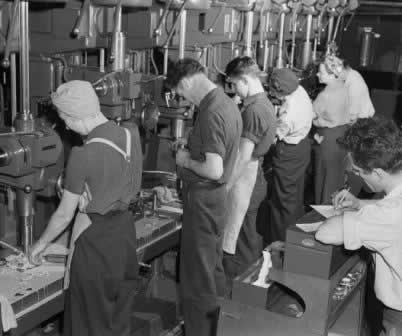 Workers at drill presses at the Ford Willow Run Plant |
The architect was Albert Kahn, who worked along side Ford designer Charles Sorensen. Six months and $47 million dollars later, the Ford Willow Run B-24 Liberty Bomber Plant was ready for training a work force. With 3.5 million square feet of factory space, it was one of the largest factories in the world. The plant featured an assembly line which was a mile long and included a unique 90 degree turn.
On October 1, 1942, the first plane was completed and christened "The Spirit of Ypsilanti." The Willow Run Airport, with six runways to test planes, was also completed in 1942.
But there was more to the story than a single large building ... it required huge infrastructure improvements in the area. In 1942, the federal government built the nation's second freeway (now I-94) to move workers and materials to the Willow Run plant. In 1943, it spent $20 million to construct an entire community adjacent to the plant. In a matter of days, the government erected dormitories for single workers and enough small houses to accommodate 3,000 people.
One thousand trailer homes were quickly added. By the end of 1943, more than 42,000 workers were employed at Willow Run.
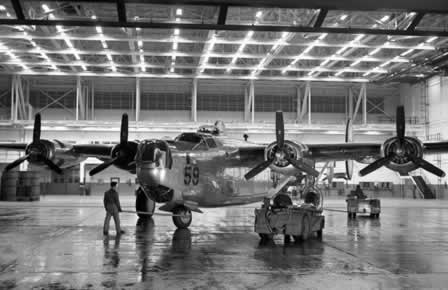 A newly built B-24 Liberator |
Willow Village provided housing for more than 15,000 people. The village grew to include 30 dormitories, six community buildings, rows and rows of small houses, commercial buildings, police and fire stations, and schools.
At the peak of production, the assembly line was producing a Liberator an hour. On June 28, 1945 production ceased, after 8,685 planes had been manufactured.
The total number of B-24s manufactured by Ford included "knock-down kits" (KDs) of all parts/portions that were then shipped by rail or truck to final assembly plants in Fort Worth and Tulsa.
Aerial view of the Willow Run plant, looking east, during WWII ... note the plant, airport and superhighway |
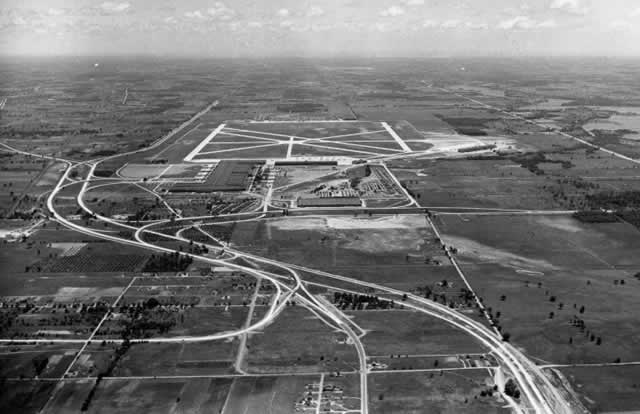 |
Ford's 6000th B-24 at the assembly plant |
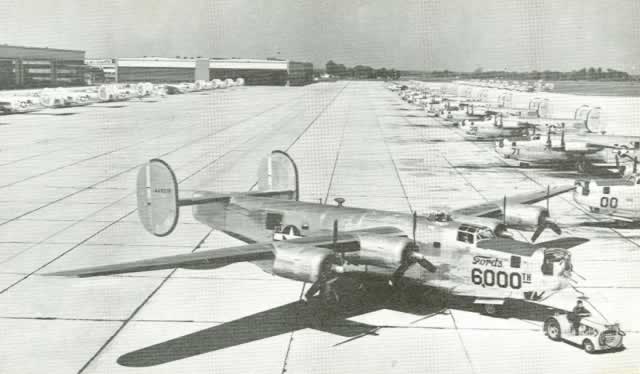 |

